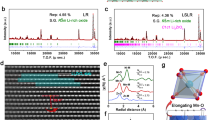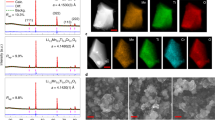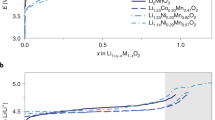Abstract
Lithium-rich cathodes are promising energy storage materials due to their high energy densities. However, voltage hysteresis, which is generally associated with transition metal migration, limits their energy efficiency and implementation in practical devices. Here we reveal that voltage hysteresis is related to the collective migration of metal ions, and that isolating the migration events from each other by creating partial disorder can create high-capacity reversible cathode materials, even when migrating transition metal ions are present. We demonstrate this on a layered Li-rich chromium manganese oxide that in its fully ordered state displays a substantial voltage hysteresis (>2.5 V) associated with collective transition metal migration into Li layers, but can be made to achieve high capacity (>360 mAh g−1) and energy density (>1,100 Wh kg−1) when the collective migration is perturbed by partial disorder. This study demonstrates that partially cation-disordered cathode materials can accommodate a high level of transition metal migration, which broadens our options for redox couples to those of mobile cations.
This is a preview of subscription content, access via your institution
Access options
Access Nature and 54 other Nature Portfolio journals
Get Nature+, our best-value online-access subscription
$29.99 / 30 days
cancel any time
Subscribe to this journal
Receive 12 print issues and online access
$259.00 per year
only $21.58 per issue
Buy this article
- Purchase on Springer Link
- Instant access to full article PDF
Prices may be subject to local taxes which are calculated during checkout






Similar content being viewed by others
Data availability
All data generated and analysed during this study are included in the published article and its Supplementary Information. Source data are provided with this paper.
References
Goodenough, J. B. & Park, K.-S. The Li-ion rechargeable battery: a perspective. J. Am. Chem. Soc. 135, 1167–1176 (2013).
Manthiram, A. An outlook on lithium ion battery technology. ACS Cent. Sci. 3, 1063–1069 (2017).
Seo, D.-H. et al. The structural and chemical origin of the oxygen redox activity in layered and cation-disordered Li-excess cathode materials. Nat. Chem. 8, 692–697 (2016).
Nayak, P. K. et al. Review on challenges and recent advances in the electrochemical performance of high capacity Li- and Mn-rich cathode materials for Li-ion batteries. Adv. Energy Mater. 8, 1702397 (2018).
Gent, W. E. et al. Coupling between oxygen redox and cation migration explains unusual electrochemistry in lithium-rich layered oxides. Nat. Commun. 8, 2091 (2017).
House, R. A. et al. First-cycle voltage hysteresis in Li-rich 3d cathodes associated with molecular O2 trapped in the bulk. Nat. Energy 5, 777–785 (2020).
Balasubramanian, M., McBreen, J., Davidson, I. J., Whitfield, P. S. & Kargina, I. In situ X-ray absorption study of a layered manganese-chromium oxide-based cathode material. J. Electrochem. Soc. 149, A176–A184 (2002).
Lyu, Y. et al. Probing reversible multielectron transfer and structure evolution of Li1.2Cr0.4Mn0.4O2 cathode material for Li-ion batteries in a voltage range of 1.0–4.8 V. Chem. Mater. 27, 5238–5252 (2015).
Ammundsen, B. et al. Local structure and first cycle redox mechanism of layered Li1.2Cr0.4Mn0.4O2 cathode material. J. Electrochem. Soc. 149, A431–A436 (2002).
Lu, Z. & Dahn, J. R. In situ and ex situ XRD investigation of Li[CrxLi1/3−x/3Mn2/3−2x/3]O2 (x = 1/3) cathode material. J. Electrochem. Soc. 150, A1044–A1051 (2003).
Lu, Z. & Dahn, J. R. Structure and electrochemistry of layered Li[CrxLi(1/3−x/3)Mn(2/3−2x/3)]O2. J. Electrochem. Soc. 149, A1454 (2002).
Zhang, L. & Noguchi, H. Novel layered Li Cr Ti O cathode materials related to the LiCrO2 Li2TiO3 solid solution. J. Electrochem. Soc. 150, A601–A607 (2003).
Mi, X., Li, H. & Huang, X. Carbon-coated Li1.2Cr0.4Ti0.4O2 cathode material for lithium-ion batteries. Electrochem. Solid State Lett. 9, A324–A327 (2006).
Zhang, L. & Noguchi, H. Novel layered Li–Cr–Ti–O cathode materials for lithium rechargeable batteries. Electrochem. Commun. 4, 560–564 (2002).
Mi, X., Li, H. & Huang, X. Electrochemical and structural studies of the carbon-coated Li[CrxLi(1/3−x/3)Ti(2/3−2x/3)]O2 (x=0.3, 0.35, 0.4, 0.45). J. Power Sources 174, 867–871 (2007).
Eum, D. et al. Voltage decay and redox asymmetry mitigation by reversible cation migration in lithium-rich layered oxide electrodes. Nat. Mater. 19, 419–427 (2020).
Boldyrev, V. V. Mechanochemistry and mechanical activation of solids. Russ. Chem. Rev. 75, 177–189 (2006).
Shi, T. et al. Shear-assisted formation of cation-disordered rocksalt NaMO2 (M = Fe or Mn). Chem. Mater. 30, 8811–8821 (2018).
House, R. A. et al. Lithium manganese oxyfluoride as a new cathode material exhibiting oxygen redox. Energy Environ. Sci. 11, 926–932 (2018).
Luo, K. et al. Charge-compensation in 3d-transition-metal-oxide intercalation cathodes through the generation of localized electron holes on oxygen. Nat. Chem. 8, 684–691 (2016).
Lee, J. et al. Reversible Mn2+/Mn4+ double redox in lithium-excess cathode materials. Nature 556, 185–190 (2018).
Takeda, N. et al. Reversible Li storage for nanosize cation/anion-disordered rocksalt-type oxyfluorides: LiMoO2–x LiF (0 ≤ x ≤ 2) binary system. J. Power Sources 367, 122–129 (2017).
Takeda, N., Ikeuchi, I., Natsui, R., Nakura, K. & Yabuuchi, N. Improved electrode performance of lithium-excess molybdenum oxyfluoride: titanium substitution with concentrated electrolyte. ACS Appl. Energy Mater. 2, 1629–1633 (2019).
Suo, L. et al. Fluorine-donating electrolytes enable highly reversible 5-V-class Li metal batteries. Proc. Natl Acad. Sci. USA 115, 1156 LP–1151161 (2018).
Wang, J. et al. Superconcentrated electrolytes for a high-voltage lithium-ion battery. Nat. Commun. 7, 12032 (2016).
Davenport, A. J. et al. In situ X‐ray absorption study of chromium valency changes in passive oxides on sputtered AlCr thin films under electrochemical control. J. Electrochem. Soc. 138, 337–338 (1991).
Manceau, A. & Charlet, L. X-ray absorption spectroscopic study of the sorption of Cr(III) at the oxide-water interface: I. Molecular mechanism of Cr(III) oxidation on Mn oxides. J. Colloid Interface Sci. 148, 425–442 (1992).
Reed, J. & Ceder, G. Role of electronic structure in the susceptibility of metastable transition-metal oxide structures to transformation. Chem. Rev. 104, 4513–4534 (2004).
Reed, J., Ceder, G. & Van Der Ven, A. Layered-to-spinel phase transition in LixMnO2. Electrochem. Solid State Lett. 4, A78 (2001).
Bréger, J. et al. Effect of high voltage on the structure and electrochemistry of LiNi0.5Mn0.5O2: a joint experimental and theoretical study. Chem. Mater. 18, 4768–4781 (2006).
Kim, S., Ma, X., Ong, S. P. & Ceder, G. A comparison of destabilization mechanisms of the layered NaxMO2 and LixMO2 compounds upon alkali de-intercalation. Phys. Chem. Chem. Phys. 14, 15571–15578 (2012).
Bo, S.-H., Li, X., Toumar, A. J. & Ceder, G. Layered-to-rock-salt transformation in desodiated NaxCrO2 (x 0.4). Chem. Mater. 28, 1419–1429 (2016).
Lee, E. et al. Role of Cr3+/Cr6+ redox in chromium-substituted Li2MnO3·LiNi1/2Mn1/2O2 layered composite cathodes: electrochemistry and voltage fade. J. Mater. Chem. A 3, 9915–9924 (2015).
Karan, N. K. et al. Morphology, structure, and electrochemistry of solution-derived LiMn0.5−xCr2xNi0.5−xO2 for lithium-ion cells. J. Electrochem. Soc. 156, A553–A562 (2009).
Ren, S. et al. Improved voltage and cycling for Li+ intercalation in high-capacity disordered oxyfluoride cathodes. Adv. Sci. 2, 1500128 (2015).
Huang, J. et al. Non-topotactic reactions enable high rate capability in Li-rich cathode materials. Nat. Energy 6, 706–714 (2021).
Zheng, X. et al. Reversible Mn/Cr dual redox in cation-disordered Li-excess cathode materials for stable lithium ion batteries. Acta Mater. 212, 116935 (2021).
Hoshino, S. et al. Reversible three-electron redox reaction of Mo3+/Mo6+ for rechargeable lithium batteries. ACS Energy Lett. 2, 733–738 (2017).
Nakajima, M. & Yabuuchi, N. Lithium-excess cation-disordered rocksalt-type oxide with nanoscale phase segregation: Li1.25Nb0.25V0.5O2. Chem. Mater. 29, 6927–6935 (2017).
Chen, R. et al. Disordered lithium-rich oxyfluoride as a stable host for enhanced Li+ intercalation storage. Adv. Energy Mater. 5, 1401814 (2015).
Yamada, A., Tanaka, M., Tanaka, K. & Sekai, K. Jahn–Teller instability in spinel Li–Mn–O. J. Power Sources 81–82, 73–78 (1999).
Zuo, C. et al. Double the capacity of manganese spinel for lithium-ion storage by suppression of cooperative Jahn–Teller distortion. Adv. Energy Mater. 10, 2000363 (2020).
Ravel, B. & Newville, M. ATHENA, ARTEMIS, HEPHAESTUS: data analysis for X-ray absorption spectroscopy using IFEFFIT. J. Synchrotron Radiat. 12, 537–541 (2005).
Ravel, B. & Newville, M. ATHENA and ARTEMIS interactive graphical data analysis using IFEFFIT. Phys. Scr. 2005, 1007 (2005).
Nelson, L. J., Hart, G. L. W., Zhou, F. & Ozoliņš, V. Compressive sensing as a paradigm for building physics models. Phys. Rev. B 87, 35125 (2013).
Kresse, G. & Joubert, D. From ultrasoft pseudopotentials to the projector augmented-wave method. Phys. Rev. B 59, 1758–1775 (1999).
Kresse, G. & Furthmüller, J. Efficiency of ab-initio total energy calculations for metals and semiconductors using a plane-wave basis set. Comput. Mater. Sci. 6, 15–50 (1996).
Dudarev, S. L., Botton, G. A., Savrasov, S. Y., Humphreys, C. J. & Sutton, A. P. Electron-energy-loss spectra and the structural stability of nickel oxide: An LSDA+U study. Phys. Rev. B 57, 1505–1509 (1998).
Wang, L., Maxisch, T. & Ceder, G. Oxidation energies of transition metal oxides within the GGA+U framework. Phys. Rev. B 73, 195107 (2006).
Sun, J., Ruzsinszky, A. & Perdew, J. P. Strongly constrained and appropriately normed semilocal density functional. Phys. Rev. Lett. 115, 36402 (2015).
Kitchaev, D. A. et al. Energetics of MnO2 polymorphs in density functional theory. Phys. Rev. B 93, 45132 (2016).
Kitchaev, D. A. et al. Design principles for high transition metal capacity in disordered rocksalt Li-ion cathodes. Energy Environ. Sci. 11, 2159–2171 (2018).
Lun, Z. et al. Design principles for high-capacity Mn-based cation-disordered rocksalt cathodes. Chem 6, 153–168 (2020).
Richards, W. D., Dacek, S. T., Kitchaev, D. A. & Ceder, G. Fluorination of lithium-excess transition metal oxide cathode materials. Adv. Energy Mater. 8, 1701533 (2018).
Ouyang, B. et al. Effect of fluorination on lithium transport and short-range order in disordered-rocksalt-type lithium-ion battery cathodes. Adv. Energy Mater. 10, 1903240 (2020).
Vinckevičiūtė, J., Radin, M. D., Faenza, N. V., Amatucci, G. G. & Van der Ven, A. Fundamental insights about interlayer cation migration in Li-ion electrodes at high states of charge. J. Mater. Chem. A 7, 11996–12007 (2019).
Radin, M. D., Vinckeviciute, J., Seshadri, R. & Van der Ven, A. Manganese oxidation as the origin of the anomalous capacity of Mn-containing Li-excess cathode materials. Nat. Energy 4, 639–646 (2019).
Acknowledgements
This work was supported by the Assistant Secretary for Energy Efficiency and Renewable Energy, Vehicle Technologies Office, under the Advanced Battery Materials Research (BMR) Program, of the US Department of Energy (DOE) under contract no. DE-AC02-05CH11231. The XRD and XAS measurements were performed at the Advanced Photon Source at Argonne National Laboratory, which is supported by the US DOE under contract no. DE-AC02-06CH11357. Use of the Stanford Synchrotron Radiation Lightsource, SLAC National Accelerator Laboratory, is supported by the US DOE Office of Science, Office of Basic Energy Sciences under contract no. DE-AC02-76SF00515. This work used resources at the Spallation Neutron Source, a DOE Office of Science User Facility operated by the Oak Ridge National Laboratory. Work at the Molecular Foundry was supported by the Office of Science, Office of Basic Energy Sciences, of the US DOE under contract no. DE-AC02-05CH11231. The computational analysis was performed using computational resources sponsored by the DOE’s Office of Energy Efficiency and Renewable Energy and located at the National Renewable Energy Laboratory, as well as computational resources provided by Extreme Science and Engineering Discovery Environment (XSEDE) supported by National Science Foundation grant number ACI1053575, and the National Energy Research Scientific Computing Center (NERSC), a DOE Office of Science User Facility supported by the Office of Science and the US DOE under contract no. DE-AC02-05CH11231. M.B. is supported by the US DOE Office of Energy Efficiency and Renewable Energy (EERE) Vehicle Technologies Office (VTO) under contract no. DE-AC05-00OR22725. We thank H. Kim for assistance with the XAS measurements.
Author information
Authors and Affiliations
Contributions
J.H. and G.C. planned the project. G.C. supervised all aspects of the research. J.H. synthesized, characterized and electrochemically tested the proposed materials. J.H. also collected and analysed the ex situ XRD and XAS data. B.O. performed and analysed the theoretical calculations. Y.Z. and D.-H.K. performed the TEM characterization. L.Y. performed refinement of XRD and neutron diffraction. Z.C. helped with material characterization. Z.L. helped with the synthesis and electrochemistry. G.Z. performed the SEM characterization. M.B. helped with the XAS data collection and analyses. The manuscript was written by J.H. and G.C. and was revised by the other co-authors. All authors contributed to discussions.
Corresponding author
Ethics declarations
Competing interests
The authors declare no competing interests.
Peer review
Peer review information
Nature Materials thanks the anonymous reviewers for their contribution to the peer review of this work.
Additional information
Publisher’s note Springer Nature remains neutral with regard to jurisdictional claims in published maps and institutional affiliations.
Supplementary information
Supplementary Information
Supplementary Notes 1–4, Figs. 1–20, Tables 1–5 and references.
Source data
Source Data Fig. 1
XRD data.
Source Data Fig. 2
Electrochemistry data.
Source Data Fig. 3
XAS data of PD-LCMO.
Source Data Fig. 4
XAS data of L-LCMO.
Source Data Fig. 5
Fitted tetrahedral Cr fractions.
Rights and permissions
Springer Nature or its licensor (e.g. a society or other partner) holds exclusive rights to this article under a publishing agreement with the author(s) or other rightsholder(s); author self-archiving of the accepted manuscript version of this article is solely governed by the terms of such publishing agreement and applicable law.
About this article
Cite this article
Huang, J., Ouyang, B., Zhang, Y. et al. Inhibiting collective cation migration in Li-rich cathode materials as a strategy to mitigate voltage hysteresis. Nat. Mater. 22, 353–361 (2023). https://doi.org/10.1038/s41563-022-01467-z
Received:
Accepted:
Published:
Issue Date:
DOI: https://doi.org/10.1038/s41563-022-01467-z



